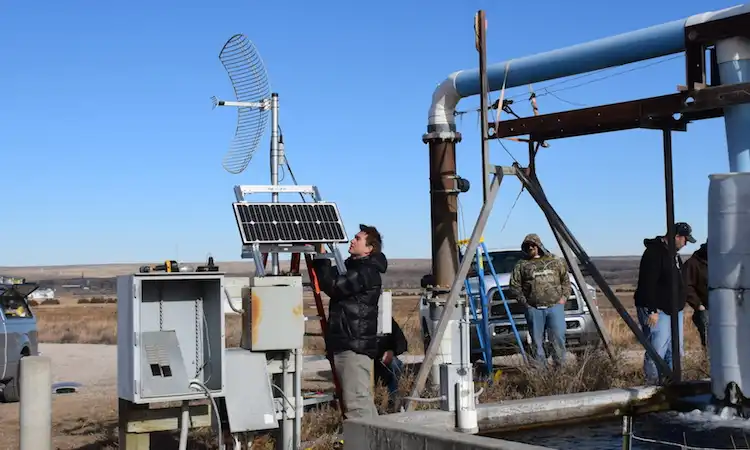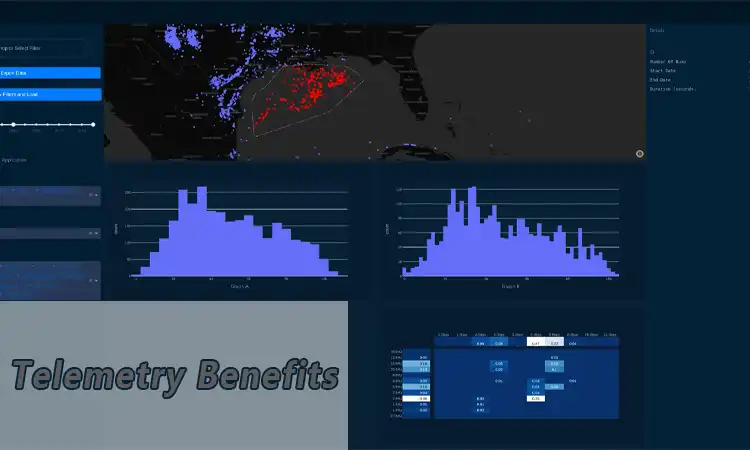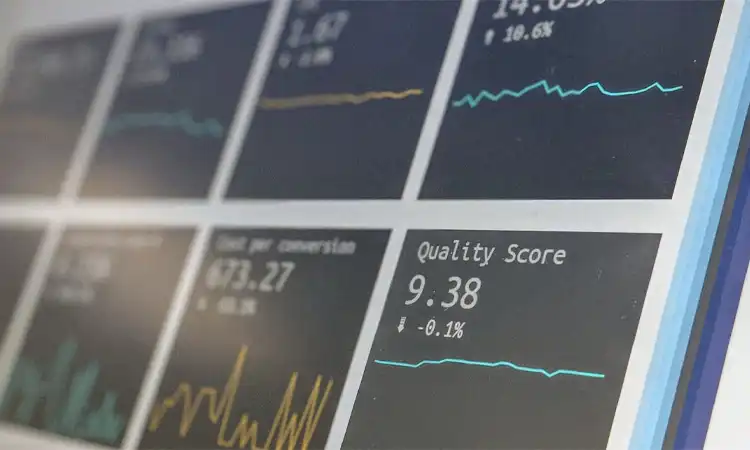In today’s data-driven world, gathering and analyzing real-time information is invaluable. Telemetry monitoring is crucial in achieving this by enabling remote data collection and providing valuable insights for informed decision-making. This article explores the concept of telemetry monitoring, how it works, its applications, benefits, and considerations regarding data security.
Telemetry Definition
Telemetry is the automatic measurement and transmission of data from remote sources. Software developers can use telemetry to access data from remote or inaccessible sources and analyze it in real time. Telemetry data can be transmitted to an IT system, which is processed and analyzed. This can be done by various methods, including radio, infrared, ultrasonic, or GSM transmission or satellite relaying.
Software developers, IT administrators, and telemetry specialists use telemetry to monitor the health and performance of applications. They use it to measure startup times and processing times, crashes and user behavior, resource usage, and system state. Telemetry is also used in meteorology, agriculture, defense, and healthcare.
What is Telemetry Monitoring?
Telemetry monitoring, also known as remote monitoring or wireless monitoring, collects and transmits real-time data from sensors to enable informed decision-making. It allows for real-time monitoring and analysis of various parameters, providing continuous insights into the monitored system’s performance, condition, or behavior.
History of Telemetry
Telemetry was first developed in 1763 when mercury pressure gauges were used to monitor the pressure in Watt steam engines from a close distance. This allows engineers to monitor the performance of their engines without getting too close.
Telemetry expanded in the early 1900s as people began using airplanes to transmit information. The first telemetry application was in 1912 when Chicago’s power plant sent operational data by telephone to a central office. In the early days, telemeters were called supervisory systems because they were used for projects like this. The buildup to World War II saw electric telemeters become more widespread. This technology became widely available after the war and was used for espionage throughout the Cold War.
In 1960, the interrogation-reply principle was developed. This enabled a more selective data transmission upon request by substituting analog for digital signals in the communication process. At that time, a telemetry transmitter consisted of a set of measuring instruments and an encoder. The encoder translated instrument readings into analog or digital signals, modulated and transmitted using a wireless transmitter with an antenna. The receiver consisted of an antenna and other components used to capture radio waves, amplify the signals and convert them into digital form for processing. A mainframe computer was used to interpret the received data and store it for later use.
How does Telemetry Work?
In general, telemetry is the process by which data from sensors at a remote source is collected and transmitted. This data collection can be physical (such as precipitation, pressure, or temperature) or electrical (such as current or voltage). It’s then converted to electrical voltages combined with timing data that forms a data stream transmitted over a wireless medium, wired, or a combination of both. At the remote receiver, this stream is disaggregated, and the original data is displayed in real-time based on user specifications. Telemetry can measure and transmit information such as temperature, pressure, and speed from IoT (Internet of Things) sensors located in automobiles, smart meters, power sources, and robots.
Telemetry monitoring relies on sensors or devices that gather data from the environment or a specific system. These sensors are equipped with transmitters, enabling them to send data wirelessly to a central monitoring system. The data collected can include vital signs, environmental conditions, equipment performance metrics, and more.
Once the data is transmitted, it is received and processed by the central monitoring system. This system typically employs sophisticated algorithms and analytics tools to analyze the incoming data in real time. The analyzed data is then visualized through intuitive dashboards, graphs, or charts. It allows users to monitor trends, detect anomalies, and gain actionable insights.
Logging and telemetry are often confused in software development. However, logging is used to diagnose errors and code flow, whereas telemetry focuses on your product’s real-world use. Once a project is released, you need telemetry enabled to collect all that raw data that becomes valuable analytics.
Telemetry is an essential part of the rapidly growing field of IoT. It allows remote devices to communicate with a central server over the internet. This data can be transmitted via computer networks, satellites, cables, and infrared technology.
Applications of Telemetry Monitoring

Healthcare
Remote patient monitoring systems have revolutionized healthcare by enabling continuous monitoring of vital signs from a distance. Advanced sensors and wireless data transmission allow healthcare providers to detect deviations from normal health parameters and intervene promptly. Real-time insights improve patient care, detect health issues early, and reduce hospital readmissions.
Industrial Settings
Telemetry monitoring solutions optimize industrial operations by monitoring parameters like temperature, pressure, vibration, and energy consumption in real time. Early identification of faults and proactive maintenance prevents breakdowns and improves productivity. Remote monitoring reduces operational costs and enhances worker safety.
Environmental Monitoring
Wireless sensor networks collect real-time data on environmental parameters such as air and water quality. This data aids in understanding ecological health, identifying pollution sources, and making informed decisions. Sensor-based monitoring contributes to environmental preservation and conservation efforts.
Sports and Fitness
Wearable devices with advanced sensors enhance sports and fitness performance. Athletes and fitness enthusiasts gain insights into training intensity, recovery patterns, and performance levels. Coaches use telemetry data to tailor training regimens, monitor physiological responses, and prevent injuries. Telemetry-enabled sports equipment provides real-time feedback, improving technique and athletic capabilities.
Telemetry Monitoring Tools
Telemetry combines two words: tele (distance) and meter (measurement). Telemetry as a monitoring practice involves:
- Collecting data from sensors or devices in the field.
- Analyzing it.
- Reporting on it in real-time.
It’s a way to ensure you know what’s going on with your systems and how they perform.
Telemetry monitoring tools are essential tools for any security operation. They can help you identify and mitigate threats with incredible speed and accuracy, as well as provide a window into the health of your infrastructure.
The most common types of telemetry include:
- Real-time dashboards. This can be used by security teams to monitor the status of their systems and see if there are any problems or issues that need to be addressed immediately.
- Log parsing (also called log management). It translates log files used by log management systems into something that security analysts can analyze to determine if they’ve been compromised or altered.
- Business intelligence. It delivers data about security incidents and trends, such as seasonal variations, to drive better business decisions by providing insight into how these events affect your organization’s bottom line. This helps you make better decisions about what actions you should take next.
- Automation tools. It automatically detects security risks and other problems before they become significant issues for your organization by identifying potential threats before they become an issue for users or systems.
Types of Telemetry Monitoring
Software developers can use IT monitoring tools to gather telemetry data about the application’s servers. The following are some key metrics to monitor during software development:
Servers Telemetry
Servers are critical to IT infrastructure since they can send and receive data from remote networks. Server metrics include processor use, server statistics, and user activity and requests.
- Processor use. A computer’s CPU is its central processing unit, or “brain,” which is responsible for handling tasks in an automated manner. Overuse of the CPU indicates that some application or feature of the machine is not being used. For example, if an application is not being used as much as it should be at certain times of day, this may indicate that it’s requesting more resources than it needs.
- Server statistics. It provides insight into server performance and use. One important statistic is CPU utilization, which indicates whether issues with CPU use are the fault of out-of-date or failing servers or they’re a problem with the application itself. Suppose a server is oversubscribed in virtualization, CPU, physical memory, or the input/output load over time. In that case, it’s essential to determine whether the problem is with the application or the server itself.
- Server performance and use data. This gives insight into how well your servers are working and how well users are accessing your site.
Network Telemetry
Networks are critical to the operation of any organization and should be monitored regularly. The following are four parameters that should be tracked:
- Bandwidth capacity is measured in bits per second, which reveals how well the network is used while processing applications.
- Application use indicates potential performance, functional, and security issues.
- Port monitoring can help identify potential security breaches and routing delays and determine whether storage is near capacity or has poor data retrieval speeds.
- Monitoring storage will help you know if your backup system has failed or if there are other issues affecting your IT needs.
Applications Telemetry
Application telemetry is essential to understand your customers and users by measuring their experience with your application. It helps you fine-tune your application to get the best results from it.
- Database access and monitoring are vital because they can slow performance.
- Database processing involves monitoring the number of database queries, response times, and the amount of data passed between an application and a database.
- Errors are also an issue; they might indicate a failure or a breach in security.
- Application key performance indicators (KPIs) measure transactions per second, request throughput, and latency. For example, in e-commerce, KPIs measure sales and database growth.
- Application monitoring is essential for DevOps activity. It tracks application deployments and software development.
Cloud Telemetry
Telemetry in the cloud is about the health of your cloud and the connectivity to it. It includes monitoring the following:
- Availability: This includes monitoring the availability of your shadow, including internet routing and energy consumption.
- Routing: This includes monitoring how well connections between your data centers work.
- Utilization: This includes monitoring how much capacity is used by individual cloud applications or services.
- Latency: This includes monitoring request latency, which is an essential factor in ensuring you have enough resources available to handle all your requests at once.
Users Telemetry
User telemetry is the process of analyzing user experience data from users’ perspectives. This includes identifying problems and symptoms before users do, which leads to faster problem resolution and better user satisfaction.
Telemetry Benefits
Telemetry is the process of collecting and reporting data from systems, devices, or machines. It can improve the performance of your organization’s applications and services, monitor how users interact with your products, and identify problems before they become serious issues.

With telemetry, admins can gather information in real-time from any remote location without interacting with users. This allows them to give feedback to developers as they work on new features or fix bugs. Admins can also use this data to identify user behavior patterns to improve their offerings over time.
Telemetry also improves performance by monitoring metrics such as the frequency with which users engage with your website or mobile app and how long it takes them to complete tasks like signing up for an account or uploading a picture. Knowing these things will help you decide what features need to be improved or what areas need more attention from developers who can add more functionality based on user needs and expectations.
In addition to providing real-time insights into application performance, telemetry helps admins monitor activity within their networks by tracking metrics such as page views per minute (PVPM), bounce rates, and session duration.
Telemetry Drawbacks and Challenges
Telemetry is a powerful tool for monitoring and managing the health of your IoT devices.
Many business owners use telemetry to monitor how their devices are performing, but they often overlook some critical aspects of the technology. Here are three key challenges with telemetry systems:
- With so many devices gathering information, it cannot be easy to access data quickly and efficiently. Users are often concerned about privacy, so they may turn off telemetry for their own reasons.
- And as more and more devices gather data, the amount of data generated by each device increases. This can be problematic for systems with limited storage capacity or cannot handle the volume of data produced.
- Legacy issues can make working with telemetry systems difficult for some applications.
Fortunately, there are some solutions available if you’re facing these challenges. One option is Simple Network Management Protocol (SNMP), which works better with older devices that do not support telemetry technology. SNMP offers other benefits such as security, scalability, and flexibility—all key factors when trying to manage large amounts of data from hundreds or thousands of different sources across your network.
Telemetry is a powerful tool that can help you determine where to focus your effort and help you pinpoint problems in your system. While the total value of telemetry may be challenging to measure right now, at least you can start evaluating your current processes via this technology. The more you can automate and make it accessible, the sooner you’ll find the value in telemetry as a reporting tool.
About Telemetry Monitoring FAQs
-
Q1: What types of data can be collected through remote monitoring systems?
A1: Remote monitoring systems can collect vital signs, environmental parameters, equipment performance metrics, and movement patterns.
-
Q2: How is remote data monitoring different from traditional data collection methods?
A2: Remote data monitoring enables real-time data collection from a distance, eliminating constant human intervention or manual measurements.
-
Q3: Can remote monitoring systems integrate with existing infrastructure and technologies?
A3: Yes, remote monitoring systems can seamlessly integrate with sensors, devices, networks, and data management systems.
-
Q4: What challenges are associated with remote data monitoring?
A4: Challenges include reliable data transmission, power requirements for wireless sensors, managing and analyzing large volumes of data, and ensuring data security and privacy.
-
Q5: How can remote monitoring systems improve efficiency in industrial settings?
A5: Remote monitoring systems provide real-time insights for predictive maintenance, optimized production processes, and resource allocation.
-
Q6: Can remote monitoring systems be used for predictive analytics?
A6: Yes, data collected through remote monitoring systems can be analyzed for predictive analytics to anticipate and address potential issues proactively.
-
Q7: Are there regulatory considerations for remote monitoring systems in healthcare?
A7: Yes, remote monitoring systems must comply with patient data privacy and security regulations, ensuring protection during data collection, transmission, and storage.








